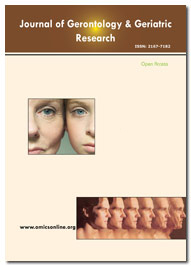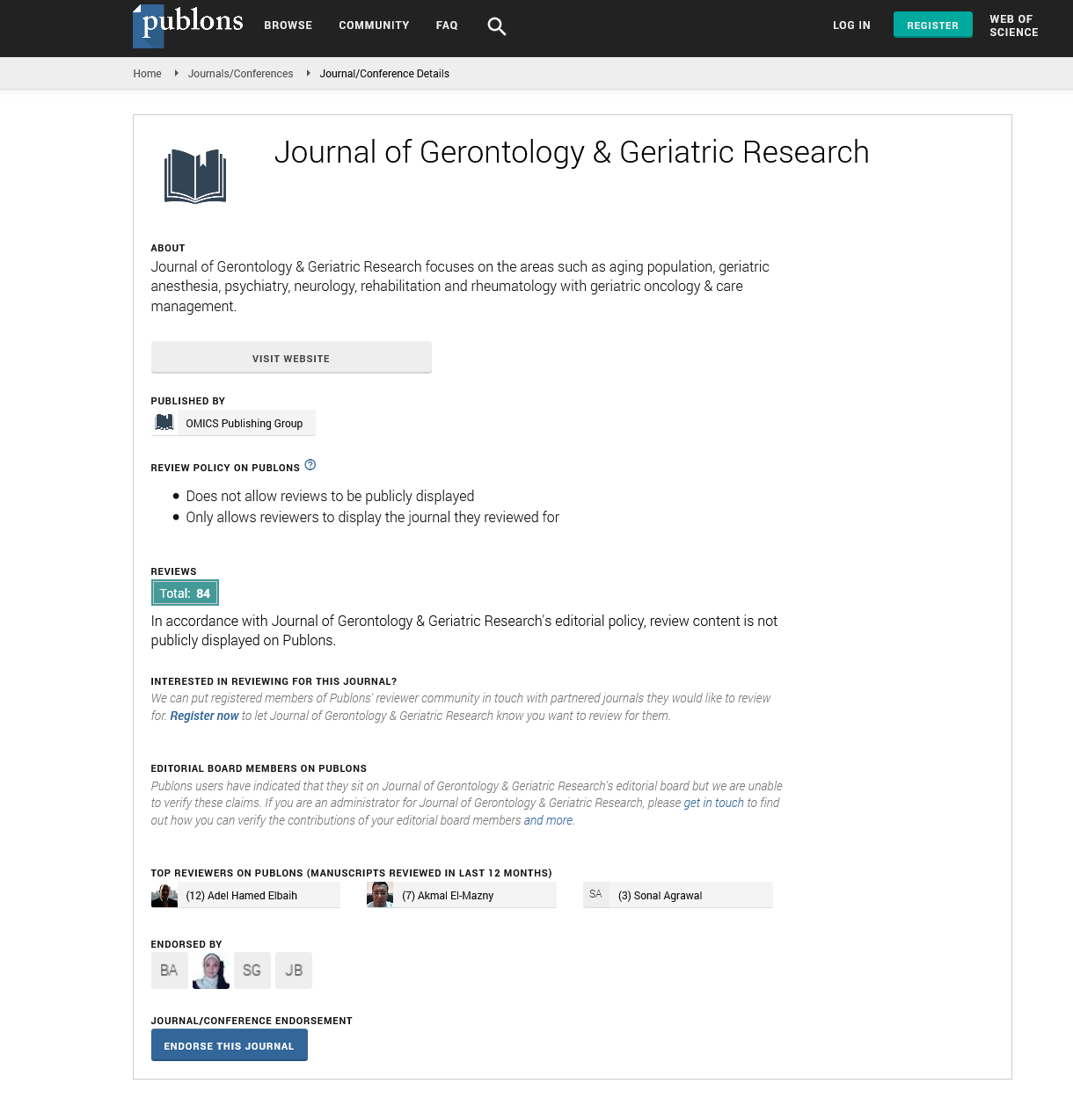Indexed In
- Open J Gate
- Genamics JournalSeek
- SafetyLit
- RefSeek
- Hamdard University
- EBSCO A-Z
- OCLC- WorldCat
- Publons
- Geneva Foundation for Medical Education and Research
- Euro Pub
- Google Scholar
Useful Links
Share This Page
Journal Flyer

Open Access Journals
- Agri and Aquaculture
- Biochemistry
- Bioinformatics & Systems Biology
- Business & Management
- Chemistry
- Clinical Sciences
- Engineering
- Food & Nutrition
- General Science
- Genetics & Molecular Biology
- Immunology & Microbiology
- Medical Sciences
- Neuroscience & Psychology
- Nursing & Health Care
- Pharmaceutical Sciences
Mini Review - (2022) Volume 11, Issue 6
Causes for Health Disparities in Older Populations
Diana Amundsen*Received: 02-Jun-2022, Manuscript No. JGGR-22-18142; Editor assigned: 04-Jun-2022, Pre QC No. P-18142; Reviewed: 14-Jun-2022, QC No. Q-18142; Revised: 20-Jun-2022, Manuscript No. R-18142; Published: 25-Jun-2022, DOI: 10.35248/2167-7182.2022.11.617
Introduction
Given the large number of migrants and asylum seekers who seek safety in different cultures around the world, ethnic equality in access to medical services is essential. These populations are thought to receive lower-quality treatment, which emphasises the need to modify the healthcare systems to account for the diverse health habits, contextual variables, language difficulties, lower levels of health literacy, and restricted access to timely care. Enhanced health literacy, policies that take into account the various requirements of majority and minority groups, and sophisticated research are all necessary for improving fairness and access to medical treatment. These actions will be implemented simultaneously, which will be in line with the global effort to promote the Sustainable Development Goals (SDGs) [1].
Sustainable Growth Goal 3 acknowledges that health needs and factors change throughout the course of a person's life and seeks to ensure healthy lifestyles and promote wellbeing for all. Even while many older people live long and in good health overall, ageing is a natural process, Involves a rising danger of illness. It is believed that age is the most significant factor. a factor affecting health. However, despite the fact that older people generally require more medical care than younger age groups, they also experience significant barriers to obtaining suitable, affordable, and highquality medical attention. Biological changes are a part of ageing, but it also represents the cumulative impact of one's exposure to Environmental dangers, like an unhealthy diet, and social factors, like isolation, can also have an impact. About 25% of the causes of disease are thought to be genetic [2].
Description
Aspects of the natural and physical environment, such as air pollution and accessibility, risky behaviours, such as smoking and inactivity, and personal characteristics, such as occupation, level of income, or education, can also play a role in determining differences in health and function in old age. Furthermore, because these variables are frequently linked, older people's unique features may have an influence over other health determinants. So discrepancies in old age, health, and other areas frequently reflect accumulated factors disadvantage due to ageist attitudes and behaviours, a lack of or insufficient laws and rules, one's location, gender, and socioeconomic status, as well as their enforcement measures that promote equality [3].
Analysis of socioeconomic, racial/ethnic, nativity, regional, and gender disparities in health and mortality, as well as period/cohort hazards and their underlying social/biological reasons, are all included in the book Health Disparities in Aging. Since Year 1, a key focus of study at PARC has been the study of health disparities in ageing. In addition to period and cohort risks and their underlying social and biological mechanisms, it takes into account socioeconomic inequalities, racial/ethnic and gender differences, variance in health outcomes by place of nativity, and variation in health outcomes by period of time. The size and persistence of racial and ethnic differences in the United States varies by racial or ethnic group, gender, and nativity status. U.S. life expectancy has decreased and socioeconomic inequalities in mortality and inequalities by location of residence have increased a tendency that has drawn substantial public attention [4].
Long-standing partnerships between Elo and Preston on racial/ ethnic and socioeconomic mortality disparities that have lately expanded to include the role of diabetes and obesity in US mortality trends and differentials serve as the foundation for classic examples of work under this theme. Their research now includes a trend and differential analysis of spatial death inequalities and their correlates in the United States under an NIA R01 (Elo, PI). Boen investigates how structural racism shapes how people experience psychosocial stress, encourages persistent activation of the body's physiological stress response systems, and ultimately plays a role in differences in the onset and course of disease. Elo researches nativity-based mortality differences in the United States and, in cooperation with Guillot, corresponding differences in France. Guillot has created new approaches in formal demography to comprehend death rates better [5].
In many nations, it is difficult for minority ethnic groups to get healthcare services, especially among the older population. It has been discovered that elderly members of minority groups use fewer healthcare services, such as preventive care, acute hospital care, cutting-edge technology operations, and rehabilitation. There is a need to evaluate the overall outcomes, including mortality rates over time, functionality of discharged patients, quality of life, and/or unplanned readmissions that may indicate subpar hospital discharge processes. Universal health coverage is unable to address all healthcare’s’ access disparities. It is important to look into how older individuals from minority ethnic groups feel about the healthcare system and how it affects their willingness to use medical services.
Conclusion
Both domestically and internationally, healthy ageing is a significant public health issue. According to the World Health Organization (WHO), good ageing is a process that enables individuals of all ages to live a safe, healthy, and inclusive lifestyle (1). However, it is well known that disparities encountered from early on in life and all during the course of one's life threaten healthy ageing. The social determinants of health have a significant impact on health and well-being, even when considering only the delivery of health and social services. These elements include the standard of living, access to education, social interaction, climatic change, and local environmental harm. To lessen inequities, action on these social determinants of health is required across the life course. WHO also recommends an approach known as "health in all policies".
REFERENCES
- MacLeod S. “The impact of inadequate health literacy on patient satisfaction, healthcare utilization, and expenditures among older adults.” Geriatr Nurs. 2017;38:334-341.
- Berkman ND. “Low health literacy and health outcomes: an updated systematic review.” Ann Inter Medic. 2011;155:97-107.
- Muñoz B. “Knowledge of diabetic eye disease and vision care guidelines among Hispanic individuals in Baltimore with and without diabetes.” Arch Ophthalmol. 2008;126:968-974.
- Chou CF. “Barriers to eye care among people aged 40 years and older with diagnosed diabetes, 2006–2010.” Diabetes Care. 2014;37:180-188.
- Blanco I. “Addressing health disparities in medical education and clinical practice.” Rheum Dis Clin 2020;46: 179-191.
Google Scholar, Crossref, Indexed at
Google Scholar, Crossref, Indexed at
Google Scholar, Crossref, Indexed at
Google Scholar, Crossref, Indexed at
Citation: Amundsen D (2022) Causes for Health Disparities in Older Populations. J Gerontol Geriatr Res. 11: 617.
Copyright: © 2022 Amundsen D. This is an open-access article distributed under the terms of the Creative Commons Attribution License, which permits unrestricted use, distribution, and reproduction in any medium, provided the original author and source are credited.

